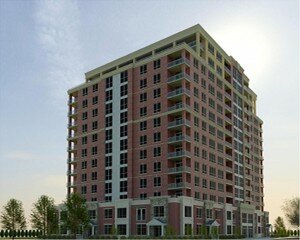And more time for public input

What the Molinaro building on Brock/Elgin will look like - without showing the four highrises that surround it.
There was spirited debate at council recently over community benefits negotiated when height and density is granted beyond that allowed in the Official Plan.
Residents at my Ward 2 Citizens Advisory Committee had raised concerns about the use of Section 37 community benefits (named for the relevant section in the Planning Act), and specifically about the benefits negotiated on the Molinaro project on Brock & Elgin. It was approved 6-1 by council (I dissented) at 14 storeys, where the Official Plan allows seven; $500,000 in community benefits were negotiated, including burial of hydro wires, landscaping, playground improvements and public art.
I shared your concerns with my council colleagues, as did many of you directly. The good news is that the public will now have input into determining community benefits. Councillor Paul Sharman and I brought a staff direction to review opportunities for public input into Section 37 discussions, which was supported by council.
Pros and cons of Section 37
There remains considerable concern in the community about the use of Section 37.
A staff report outlining the process for obtaining Section 37 benefits states that community benefits may be used “to allow increases in height and density of development beyond those permitted by the Zoning By-law in exchange for facilities, services, or matters of public benefit.” The fundamental requirements of using Section 37 are that the “proposal represents good planning and the benefits are consistent with Official Plan policies.” Read the report here.
Members of my Ward 2 Citizens Advisory Committee said they’d rather the Official Plan height limits be followed, and not accept community benefits. If 14 storeys is good planning, then that’s what the Official Plan should read.
The counterargument – expressed by several residents who also contacted me – is that if 14 storeys will be built no matter what, because it can be defended on the basis of good planning, we might as well get $500,000 in benefits.
Benefits should relate to the development
Even among those who support community benefits, there is considerable debate about what they should fund. A report by the law firm Fraser Milner Casgrain reviewed Ontario Municipal Board decisions on Section 37 and found they favoured benefits directly related to the development, unless they are agreed to voluntarily. The Planning Act is “not a revenue statue,” the OMB stated in the Stirling Silver decision, and the benefits must be connected to the specific development “not to unrelated municipal projects (no matter how meritorious).”
Read the report, entitled Section 37: An Update on “Let’s Make A Deal” Planning, here.
Part of the concern I heard about the Molinaro/Brock community benefits were the benefits themselves – they were seen to add value to the development or be unrelated to it (for example public art). I share that concern.
We’ll have an opportunity for more discussion on the use of Section 37 during the Official Plan review in 2012.
More time for public input
Counc. Sharman and I also co-sponsored a staff direction to provide more time for public input following the release of a staff report on a development. In the Molinaro case, the report was released one week before the statutory public meeting and vote on the development, which occurred in the same meeting. The staff direction asks for more time between the release of the staff report and the vote, to allow residents to review the report (they can be hundreds of pages) and provide thoughtful and organized feedback to council.
My take: We’ve taken two steps in the right direction to improve public input on major developments and on community benefits, and I’m pleased to have worked with residents and my colleagues to achieve that. I remain concerned about the use of community benefits, and can see only limited opportunities for their use, for example securing low-cost assisted living units. I don’t support community benefits funding items that should be funded as part of our regular budget, for example public art.


